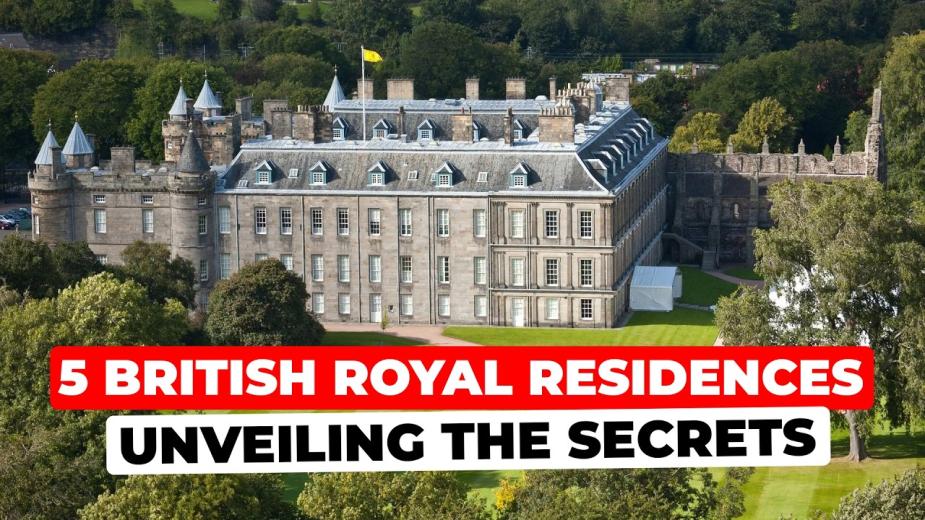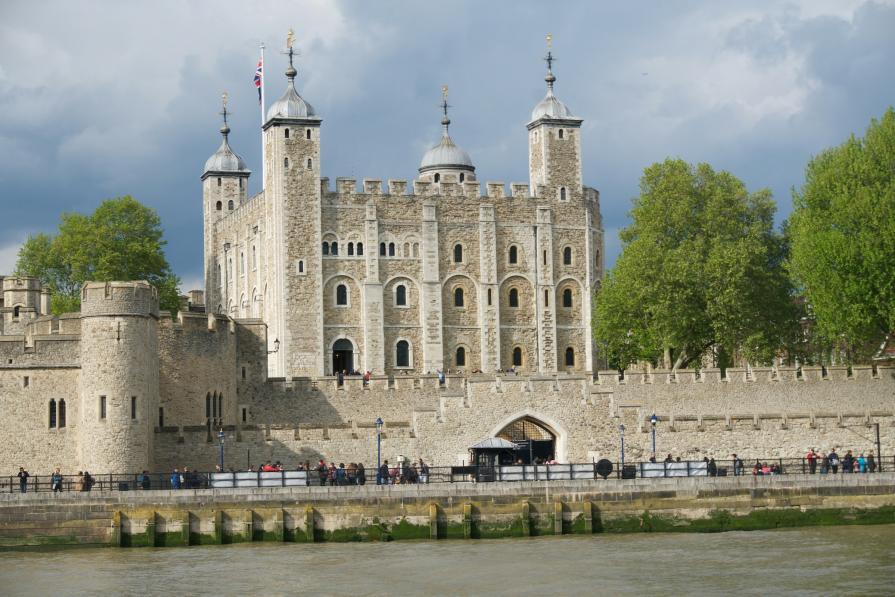Britain boasts countless impressive castles, from medieval fortresses to dramatic cliff-top ruins. They made the country's history, mysterious incidents and romantic stories took place, and today are home to museums and hotels, some used for celebrations, concerts and weddings. Some ancient castles are still owned by noble families of England (including royal families), but most are open to visitors, which has made ancient castles an important component of domestic and international tourism.

Windsor Castle
Windsor Castle proudly bears the title of the oldest and largest castle in the world (its area is 5 hectares, 13 acres) - the royal family still lives here. Located in Berkshire, the royal residence was built in the 11th century, the construction took about 16 years. The castle was originally intended to protect London from the approach of enemy troops from the west, but the place quickly became popular for its location and proximity to the royal hunting grounds. The structure of the castle consists of two four-sided building complexes that are separated by the Round Tower, visible from afar. Currently, the Queen uses the castle as her weekend home and also as a royal residence when service does not require a presence in London.
Tower of London
The Tower of London attracts about 3 million tourists every year, and although it is known as a prison, it is one of the most popular castles and fortresses in England. The massive White Tower is a typical example of Norman military architecture whose influence was felt throughout the kingdom. It was built on the Thames by William the Conqueror to protect London and establish its authority, creating a symbol of strength and longevity for the new order. Around the White Tower was built the Tower of London, an impressive fortress, one of the symbols of royal power. The Tower of Prison was the center of the imprisonment of Edward V, his younger brother, four English queens, three of whom were executed in the Green Tower - Anne Boleyn, Katherine Howard and Jane Grey.
The security of the Tower's palatial structures offers a rare opportunity to see the life of a medieval monarch inside the castle walls. The Tower of London is a unique example of an ensemble of buildings, built from the 11th to the 16th centuries, which has survived to this day.

Tintagel Castle
Tintagel in Cornwall is one of Britain's most famous castles. The lands around Tintagel Castle have been settled since the late Roman period, and in the 5th-7th centuries it was economically one of the most important places in Britain, closely linked to trade relations with the eastern Mediterranean.
Interestingly, from the middle of the 7th century onward. Tintagel has little evidence of activity for over 500 years. It wasn't until about 1138 that Tintagel became famous after a mention in Geoffrey's History of the Kings of Britain: the author refers to the castle as the place where King Arthur was magically conjured - and although this story involves deception, it makes Tintagel popular with tourists to this day. The ruins of the 13th-century castle offer stunning views; Tourists visit the famous Merlin Cave nearby. There is a bronze sculpture of King Arthur on the grounds, and the great wizard's head is carved into the rock below the castle.
Sterling Castle
Sterling is a Scottish fortress with one of the richest histories of biography. The battle of Bannockburn in 1314 and the coronation of nine-month-old Mary Stuart in 1543 took place here. Located on top of a volcanic cliff, Castle Hill, Stirling has been attacked or besieged at least 16 times, resulting in several murders. walls, including here the Scottish James II murdered William, 8th Earl of Douglas, breaking his own security guarantees. According to BBC iWonder, the castle was of great strategic importance because of its location near the Scottish-Highland border.
In recent years, the castle grounds have been used for open-air concerts - Bob Dylan, the Ram. Every year the castle hosts Hogmanay, a celebration of the last day of the year, dating back to pagan traditions.
Cardiff Castle
Cardiff was built by William the Conqueror in 1081 on the site of a Roman fort; the original version was made of wood. The castle was involved in a series of conflicts between Anglo-Normans and Welsh, in 1404 the Welshman Owain Glynder took the storm, who for six years tried (ultimately unsuccessfully) to rebel against English rule in Wales. Cardiff changed hands several times after the Rose Wars and eventually became Crown property. Beginning in 1866, the 3rd Marquis of Butte hired renowned architect William Burgess to transform the castle's interior: he created sumptuous interiors in the Gothic towers, rich in frescoes, stained glass, marble, gilding and elaborate wood carvings. Each room has a special theme, including Mediterranean gardens, Italian and Arabian decor. After the death of the 4th Marquis, the family decided to give the castle and most of its parks to the city of Cardiff. For 25 years the castle housed the National College of Music and Drama, and since 1974 it has become one of the most popular attractions in Wales.

Edinburgh Castle
Built in the 11th century on the rock of Edinburgh Castle, Edinburgh Castle remained a Scottish royal residence until the Union of the Crowns in 1603. Queen Margaret (later canonized) lived and died here, and Mary, Queen of Scots, gave birth to the future Jacob. VI in the royal palace of the castle in 1566. The castle changed hands many times during the Scottish wars of independence, managing to become a place of witchcraft trials: in 1537, during the reign of the infamous royal witch hunter James VI, Janet Douglas was put on trial and later burnt at the stake just outside the castle walls by Lady Glamis.
Edinburgh Castle was bombed by German bombs from the Zeppelin dirigible in 1916 and during World War II. Today Edinburgh Castle is home to the Stone of Destiny, which was used to enthrone Scottish monarchs in Iona, Dunad and Skåne. The stone was brought to the castle in 1996 after 700 years in Westminster Abbey.
Heickler Castle
The famous multi-part film series "Downton Abbey" took the environment of Highclere Castle as its base to create the park and surroundings of the Grantham family home. Founded on the site of a medieval palace built in the 12th and 13th centuries, Hickler presents a Tudor-era red-brick house. In 1838, the 3rd Earl of Carnarvon hired the famous architect Sir Charles Barry, who was famous for restoring the Palace of Westminster, and he transformed Hickler into a magnificent mansion.
Hickler was used as a hospital during World War I by its owner, Lady Almina, 5th Countess of Carnarvon, and the first patients who arrived from Flanders in September 1914. During World War II, Heickler Castle briefly became home to evacuated children from north London. Today it boasts more than 200 rooms (even the lady of the house doesn't know how many there are!) And is open to the public 60-70 days a year.
Carrickfergus Castle
Arguably the most famous castle in Northern Ireland, Carrickfergus was the site of many key events in the country's history. Surrounded by the sea on three sides, the fortress is located in Carrickfergus (County Antrim) on the north shore of Belfast Bay. Built on the orders of the Anglo-Norman knight John De Courcy soon after his invasion of Ulster in 1177, Carrickfergus was the only English stronghold north of the Palace in the Middle Ages (that is, the part of Ireland that was under direct control). For many years the castle controlled Belfast Bay, passed from hand to hand several times from the Normans to the Scots and then to the English, after King John besieged it in 1210. Today it remains one of the best preserved medieval structures in Ireland.

Dunlus Castle
Dunluce is said to have served as the inspiration for C.S. Lewis' castle during the creation of the fictional Automobile Parawal in The Chronicles of Narnia. The ruins of Dunluce Castle are located on the rocky coastal cliffs of North Antrim. Built by the MacQuillan family in 1500, the castle was given to the MacDonnell clan in the 1550s when Sorley Boy MacDonnell moved from Scotland to unite the MacDonnell territories in Ireland.
In October 1588, the Spanish galleys of the Girona, part of the famous Armada, crashed in a storm on the rocks near Dunluce Castle. According to legend, the Spanish treasure was taken from the boats to the Mermaid's Cave, which is 25 meters below the castle. Some believe that the Armada sailors are buried in the nearby ruins of St. Cuthbert's Church.
Dunluce Castle is still owned by the McDonnell family, but today it is managed by the Northern Ireland Environmental Protection Agency.
Caernarfon Castle
Built in 1283 by Edward I after the English conquest of Gwynedd, Caernarfon is one of the most impressive castles in Wales.
Located on the site of a former Roman fort and Norman castle overlooking the River Seyont, Caernarfon was a medieval fortress. Its considerable defensive structures included seven polygonal towers, two towers and two huge double gates. During the construction of the castle, city walls were erected around Caernarfon. Military historian Reginald Allen Brown states that Caernarfon was "one of the most formidable accumulations of firepower in the Middle Ages.
Thornbury Castle
The only Tudor castle now operating as a hotel is Thornbury Castle in South Gloucestershire, once home to Henry VIII and his fiancé Anne Boleyn. Thornbury was not designed as a fortress: rather, it is a country house, recognized today as "one of the finest examples of Tudor domestic architecture in the country." Edward Stafford, Duke of Buckingham, built the castle during Henry VIII's reign, though he could not live in it. The Duke of Buckingham was arrested for high treason and executed at Tower Hill, and Thornbury was transferred to the Crown. Henry took the castle for himself, spending ten days there during his honeymoon with Anne Boleyn. The building remained royal property until the death of Henry VIII's daughter Mary I, when it was returned to the Duke's descendants.

If you're going to the UK or planning to send your child to a private English boarding school, start exploring the country with a short trip outside London, explore the county where the school is located and be sure to visit the local castle. All the local stories, legends will unfold around the castle, many cultural traditions will be associated with it - a visit to such an ancient fortress will allow you to feel the atmosphere of the place and get to know it better.











